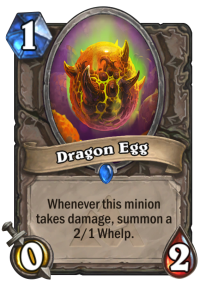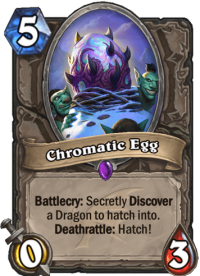If you search for “Egg” in your Hearthstone collection (and discount results like Nithogg or Eggnapper), you end up with nine different results spanning across the years. Almost all of them saw play in Standard meta decks across over a dozen different metagames. Why are these 0-Attack cards so effective, and why did we underestimate them upon their arrival? Let’s break a few eggs to find out the answers to these questions…
Separating the Yolk

Once upon a time, Naxx was out and everyone tried to figure out the power levels of Hearthstone’s first batch of new cards. Now we know that most of them were seriously overtuned, single-handedly defining metagames and remaining staple tools all the way until the introduction of Standard. Cards like Zombie Chow, Loatheb and Sludge Belcher were ever-present in slower decks while Haunted Creeper and Mad Scientist remained permanently etched into aggro decklists. Undertaker’s original form still remains the most powerful individual card in the game, with an archetype even more powerful than Demon Hunter’s launch version. Most of these cards were underestimated by the playerbase upon launch – and in many ways, Nerubian Egg was just another misunderstood soul.
On the surface, it seems like an exceedingly fair card: though a 4/4 for 2 mana would be grossly overstated by itself, the fact that you will have to invest some other resource into it to get it out on a following turn makes it both more expensive and slower than it may seem at first glance. If you can’t or won’t pop the egg by yourself, it also serves as insurance against AoE options later in the game. Of course, this was only one part of the equation, and it was quickly discovered that Nerubian Egg is in fact much more powerful than we gave it credit for: with cards and decks that can make efficient use of the initial body – think Power Overwhelming and Void Terror for Warlock back in the day or cards like EVIL Genius in the current rotation – or rely on strong permanent Attack buffs, it is basically a built-in two-for-one deal.
Soon thereafter, Goblins versus Gnomes was released, and Piloted Shredder turned out to be one of the most powerful curve cards of all time – though it takes a tiny bit of setup, Nerubian Egg was basically just as effective in more aggressive, token-based archetypes, yet not so powerful that its design had to be iceboxed. In fact, Egg cards remained a staple in the game ever since, being printed in various forms on a consistent basis across the years, with almost all of them seeing competitive play.
Sleepers and Bad Eggs

Though most Egg cards follow the same pattern – destroy the initial body and get an overstatted minion in return – there are the occasional exceptions to this rule. Blackrock Mountain’s Dragon Egg technically offered you a 2/1 minion as the Deathrattle of the 1 mana 0/2 body, but the potential to summon multiple Whelps was what made it interesting – and eventually a part of certain aggressive Warrior and Druid decks. In many ways, it served as the precursor to Scarab Egg, and arguably these Eggs with the more fragile payoffs ended up being a bit less effective than something like Devilsaur Egg or Mechano-Egg (which has become a notable card in Battlegrounds as well). Meanwhile, Serpent Egg serves as almost a functional reprint of Nerubian Egg, with a larger initial body and a smaller payoff essentially conceding the fact that the first iteration of the type ended up being a little too strong for its own good.
Eggs without a direct impact on the board state have never really been particularly relevant. One Night in Karazhan brought us Runic Egg, and it’s easy to see why it isn’t really worth the inclusion as a cycle tool even at one mana: you need to invest another card so that you can get the card, and even if you decide that’s worth it for some reason, it still means it takes an extra turn to get the payoff. It’s tough to argue for its inclusion over Novice Engineer or Loot Hoarder, for instance. Similarly, Swamp Dragon Egg was just a weak resource generation tool, though it’s notable as a highlight that the long-term support of Dragon tribal synergies necessitated cheaper Dragon minions (which wasn’t really a thing back in Classic), severely increasing the variance on any “random Dragon” payoff in the game. Dragonqueen Alexstrasza, anyone? You know what I mean.
Interestingly, all three sets from the Year of the Mammoth featured an Egg card, and two out of the three expansions in the Year of the Dragon did the same. Though Ashes of Outland doesn’t have an Egg on the menu, you could argue that the Dormant keyword serves a similar role from a gameplay perspective, with a more reliable payoff with no potential power spike.
In fact, a comparison between Nerubian Egg and Imprisoned Vilefiend is fairly instructive. Both cards offer 8 stats “hidden behind a paywall”, but the Demon comes out with Rush on the second turn. This is basically identical to a player immediately breaking up their egg on the turn after they’ve played it, setting up the minion to attack on the following one. Why was one a premium card and the other a mediocre option? As we’ve discussed earlier, the decks that can effectively utilize Egg cards are the ones which can make good use of the first, 0-Attack body in an efficient manner. Imprisoned Vilefiend offers no first body and no special payoff, therefore making it an inferior – read: more balanced – option.

Having all this in mind, it’s easy to figure out why Descent of Dragons’ Chromatic Egg hasn’t joined the club as a top-tier deckbuilding tool, and likely never will. The secret nature of the Deathrattle is close to worthless as your opponents would almost never decide to activate the Deathrattle effect for you in the first place. However, the Dragon pool is so large that you can easily end up with poor Discover options, meaning that even a strong Deathrattle/Dragon synergy archetype would make a gamble by running this card. In a set considered by many to be borderline overpowered, its Egg stands among one of the weakest minions in the game.
Then again, who knows, maybe someone does come up with the archetype after the release of the next set which revolves around this sneaky Deathrattle effect. If that’s the case, I’ll definitely end up with egg on my face.

The understated benefit of Nerubian egg was in Zoolock, where you had so many buffing cards that the 0/2 body actually had value because you could pretty much guarantee it would stick on the board for your buff cards.
An egg basically has the text: “Guaranteed to live to next turn”, which exactly what a buffing deck ordered … then the extra body that pops out is icing on the cake.